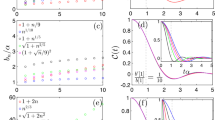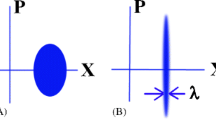Abstract
In this paper, we investigate the quantum fractional of the one-dimensional Klein–Gordon oscillator. By using a semiclassical approximation, the energy eigenvalues have been determined for oscillators. The obtained results show a remarkable influence of the fractional parameter \(\alpha\) on the energy eigenvalues. By considering a unique energy spectrum, we present a simple numerical computation of the thermal properties of a defined energy spectrum of a system. The Euler–Maclaurin formula has been used to calculate the partition function and therefore the associated thermodynamics quantities. Besides this, we also calculate the eigenfunctions of our problem. The influence of the parameter \(\alpha\) on these functions as well as the probability of density has been tested.




Similar content being viewed by others
References
B. Ross, Hist. Math. 4, 75–89 (1977)
N. Laskin, Fractional Quantum Mechanics (World Scientific Publishing Co. Pte. Ltd, Singapore, 2018)
R. Herrmann, Fractional Calculus: An Introduction for Physicists, 2nd edn. (World Scientific Publishing Co. Pte. Ltd, Singapore, 2014)
R. Hilfer, Applications of Fractional Calculus in Physics (World Scientific, Singapore, 2000)
N. Laskin, Fractional Dynamics: Recent Advances, Chapter 17 (World Scientific, Singapore, 2012), p. 393
N. Laskin, Chaos 10, 780 (2000)
N. Laskin, Phys. Rev. E 66, 056108 (2002)
N. Laskin, Phys. Rev. E 62, 3135 (2000)
V.E. Tarasov, Handbook of Fractional Calculus with Applications (Walter de Gryter, Berlin, 2019)
S.S. Bayin, J. Math. Phys. 53, 042105 (2012)
S.S. Bayin, J. Math. Phys. 53, 084101 (2012)
Y. Wei, Int. J. Theor. Math. Phys. 5, 87–111 (2015)
Y. Luchko, J. Math. Phys. 54, 012111 (2013)
N. Laskin, Phys. Lett. A 268, 298–305 (2000)
B.P.M.M. Hasan, Ann. Phys. 396, 371–385 (2018)
B.P.M.M. Hasan, Phys. Lett. A 382, 248–252 (2018)
A. Lomin, Chaos Solitons Fractals X 1, 100001 (2019)
S.I. Muslih, O.P. Agrawal, D. Baleanu, J. Phys. A Math. Theor. 43, 055203 (2010)
V.K.S.M. Tamsir, Alex. Eng. J. 55, 561–564 (2016)
V.K. Srivastava, M.K. Awasthi, M. Tamsir, AIP Adv. 3, 032142 (2013)
V.K. Srivastava, M.K. Awasthi, R.K. Chaurasia, M. Tamsir, Model. Simul. Eng. (2013)
R.K. Chaurasia, V. Mathur, R.L. Pareekh, M. Tamsir, V.K. Srivastava, Alex. Eng. J. 57, 1877–1881 (2018)
V.K.S.M. Tamsir, Alex. Eng. J. 55, 867–874 (2016)
N. Dhiman, M.J. Huntul, M. Tamsir, Eng. Comput. 38, 2921–2936 (2021)
M. Tamsir, N. Dhiman, D. Nigam, A. Chauhan, AIMS Math. 6, 3805–3820 (2021)
H.H.A. Boumali, Eur. Phys. J. Plus 128, 124 (2013)
A. Boumali, EJTP 12 (2015)
G.E. Andrews, R. Askey, R. Roy, Special Functions (Cambridge University Press, Cambridge, 2001)
R. Herrmann, Phys. A 389, 4613–4622 (2010)
F. Olivar-Romero, O. Rosas-Ortiz, J. Phys. Conf. Ser. 698, 012025 (2016)
H.C. Rosu, S.C. Mancas, J. Phys. Conf. Ser. 1540, 012005 (2020)
A. Boumali, A. Hafdallah, A. Toumi, Phys. Scr. 84, 037001 (2011)
R. Herrmann, arXiv:math-ph/0510099v4 (2006)
R. Herrmann, J. Phys. G Nucl. Part. Phys. 34, 607 (2007)
M. Berman, N. Moiseyev, Phys. Rev. A 98, 042110 (2018)
F. Mainardi, Y. Luchko, G. Pagnini, Fract. Calc. Appl. Anal. 4, 153 (2001)
H. Takayasu, Fractals in the Physical Sciences, Nonlinear Science: Theory and Applications (Manchester University Press, Manchester, 1989)
Author information
Authors and Affiliations
Corresponding author
Additional information
Publisher's Note
Springer Nature remains neutral with regard to jurisdictional claims in published maps and institutional affiliations.
Appendix: Review of the Eigensolutions of 1D Harmonic Oscillator Using the Riesz–Feller Fractional Derivative
Appendix: Review of the Eigensolutions of 1D Harmonic Oscillator Using the Riesz–Feller Fractional Derivative
This appendix is a review of the method proposed by Rosu and Mancas [31]. The method is based on factorization algorithm and uses the Riesz–Feller fractional derivative. At first, its Olivar-Romero and Rosas-Ortiz [30] were first ones to apply the factorization method to a fractional quantum harmonic oscillator. Then Rosu and Mancas [31] apply the factorization algorithm to the fractional quantum harmonic oscillator along the lines previously proposed by Olivar-Romero and Rosas-Ortiz [30] by using the Riesz–Feller fractional derivative.
Starting with the space-fractional Schrödinger equation
In his treatment about Harmonic oscillator, Laskin defined the form of the potential \(V\left( x\right)\) with \(\left| x\right| ^{\beta }\). The authors [30] fixed the parameter (\(\beta =2\)), and their arguments are that the arbitrariness of \(\beta\) makes no substantial difference in the method. However, they have specialized their study of oscillator potential \(V\left( x\right) =x^{2}\). The generalities of the method can be glimpsed the potential \(V\left( x\right)\) with the form \(\left| x\right| ^{\beta }\). The reason of this is that the effect of the fractional formulation is encoded in the momentum operator \({\hat{p}}^{\alpha }\) which is expressed in terms of the \(\alpha\)-order spatial derivative.
Now, using that \(D_{\alpha }\hbar =1\), Eq. (56) becomes
According to the factorization algorithm, we have the following: consider a pair of operators \(A_{\alpha }\) and \(B_{\alpha }\) such that
where \(\epsilon _{\alpha }\) can be a fractional-differential operator. The operators \(A_{\alpha }\), \(B_{\alpha }\) and \(\epsilon _{\alpha }\) are written as
The method consists to solve the kernel equation of
Then, this fractional derivative equation will solve it in the momentum representation p. In this stage, Rosu and Macans [31] have used the Fourier transform of the Riesz–Feller derivative \(d^{\alpha }/{\text {d}}x^{\alpha }\). The authors have been inspired by the works of Berman and Moiseyev [35] for their studies on the exceptional points in the Riesz–Feller Hamiltonian with an impenetrable rectangular potential [35]. As we known, the Fourier transform and its inversion are given by
Now, the Riesz–Feller fractional derivative \(_{x}D_{\theta }^{\alpha }\) is defined through a relation [36]
where
and
The allowed region for the parameters \(\alpha\) and \(\theta\) turns out to be a diamond in the plane \(\left( \alpha ,\theta \right)\) that are called the Feller–Takayasu diamond [31, 35, 37].
Thus, Eqs. (59) and (60) become
and the solutions of the kernel \(A_{k,\alpha }\) are
The others solutions are found by the repeated usage of the operator \(B_{k,\alpha }\).
Rosu and Mancas have proved one can write
where \({\tilde{H}}_{n}\) are the fractionally deformed Hermite polynomials (some form of this function are listed in Table 2). They also call Riesz–Feller Hermite polynomials.
Rights and permissions
About this article
Cite this article
Korichi, N., Boumali, A. & Chargui, Y. Statistical Properties of the 1D Space Fractional Klein–Gordon Oscillator. J Low Temp Phys 206, 32–50 (2022). https://doi.org/10.1007/s10909-021-02638-z
Received:
Accepted:
Published:
Issue Date:
DOI: https://doi.org/10.1007/s10909-021-02638-z




